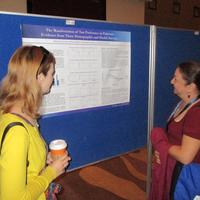This week I’ve been attending the 3rd Asian Population Association Conference in Kuala Lumpur, Malaysia. While, I have presented a paper and a couple of posters, the most interesting thing about the conference has been the interactions with fellow participants that have sparked new ideas and intellectual curiosity. One of the themes, which has really come to the fore, is the difference between ideals and intentions when it comes to fertility.
At the opening ceremony the Malaysian Minister of Women, Family and Community Development took us somewhat by surprise when she informed us that the ideal family size is four children. She quickly followed this by clarifying that the Ministry had no desire to impose this ideal on anyone, and that people should have the number of children that they want to have. However, it was interesting that the Malaysian Government is specifying an ideal number of children, and that this ideal number is so much higher than replacement level. The total fertility rate (TFR) of Malaysia has not been above 4.0 since the 1970s, and is now slightly below 2.0. Perhaps, the Malaysian Government is simply specifying a very high number in the hope of increasing its fertility rate by a small amount, or perhaps they really do believe that a TFR of 4.0 would be ideal for the country as a whole. Either way it is clear that the ideal level of fertility might differ widely depending on for whom it is ideal.
For the world as a whole it is pretty clear that a TFR of anywhere near 4.0 would be disastrous; the planet has finite resources and that level of population growth would ultimately lead to increased food scarcity, increased numbers of environmental refugees, increasing levels of violence and many other consequences. However, it might be that for an individual country it does make sense to have a TFR of 4.0 (or more). In the wake of conflict where a large proportion of the population died, there is often a resurgence in fertility in order to replace the deceased (for example in Timor-Leste). At the individual level, it might be ideal for an individual or couple to have any number of children. Some people do not want children at all, while some people would like lots, but are mindful that they cannot provide education, healthcare and food for a large number of children. If you were asked, “what is your ideal number of children”, what would you say? Would you simply answer with the number of children you already have? Would you answer as though you lived in an ideal world and as though money was no object? Would you consider the impact of your offspring on the world? Would you consider a government message about the ideal number of children, or what your friends and family think is an ideal? Would you be able to answer at all?
What if, on the other hand, you were asked “do you intend to have any more children within the next two years?” It is much more likely that you could provide a concrete answer to this question, which would be likely to correlate much more closely with whether you have any more children. This is because you are being asked a practical question and being asked about the real world. Thus this question is much more useful if all we want to know about is what will happen to fertility in the short term. However, it might not be that useful if we are interested in the next ten years, or the next fifteen years. Would the question about your ideal number of children, then be more useful? Perhaps that question tells us about societal ideals, and therefore potential future fertility trends better.
I do not have the answers, but I think this conference has made clear to me that as demographers we need to consider more carefully the subtleties of survey questions being asked. The exact wording of a question is important. Ideals and intentions are very different things, though both can be useful in different situations.
About the Author:
Dr Melanie Channon (nee Frost) is a Research Fellow at the Oxford Institute of Population Ageing working on the Collen Programme. Melanie is a trained demographer and social statistician, and her primary areas of research interest are the drivers of fertility transition in developing countries, son preference, and gender statistics. She has expertise in the demography of both Asia and Africa, with a focus on Nepal and South Asia.
Opinions of the blogger is their own and not endorsed by the Institute
Comments Welcome: We welcome your comments on this or any of the Institute's blog posts. Please feel free to email comments to be posted on your behalf to administrator@ageing.ox.ac.uk or use the Disqus facility linked below.













